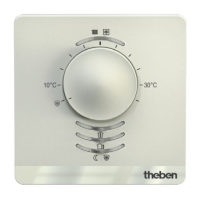The application programmes RAMSES 718 P/S
RAMSES 718 P / RAMSES 718 S 45
4.6.5 Heating set points
Base set point after loading the
application
21 °C, 22 °C, 23 °C
Output set point for temperature
control.
Minimum valid base set point
increments
Std.: 10 °C
If the object receives a base set
point which is lower than the
minimum valid base set point,
the base set point will be
increased to the value set here.
Maximum valid base set point
increments
If the object receives a base set
point which is higher than the
maximum valid base set point,
the base set point will be set to
Maximum valid set point offset
+/- 2 K
+/- 3 K
+/- 4 K
Limits the possible setting range
for the set point offset function.
Applies to both the
man. set point offset
as well as the rotary control17.
Reduction in standby mode
(when heating)
2 K, 2.5 K, 3 K, 3.5 K,
4 K, 4.5 K, 5 K
Example: for a base set point of
21°C in heating mode and a
reduction by 2K, the device
regulates with a set point of 21
Reduction in night mode (during
heating)
6 K, 7 K, 8 K
temperature be reduced in night
set point for frost protection
mode (during heating)
Std.: 6 °C
Preset temperature for frost
protection mode in heating mode
(Heat protection applies in
cooling mode).
Current set point in comfort
mode
Feedback of current set point
value via the bus:
<> cooling)
The set point actually being used
for control is always to be sent
(= current set point).
Example with Base set point
21 °C and dead zone 2 K:
During heating, 21 °C is
transmitted and during cooling,
base set point + dead zone is
transmitted
(21 °C + 2 K = 23 °C)
17
Only RAMSES 718 P

